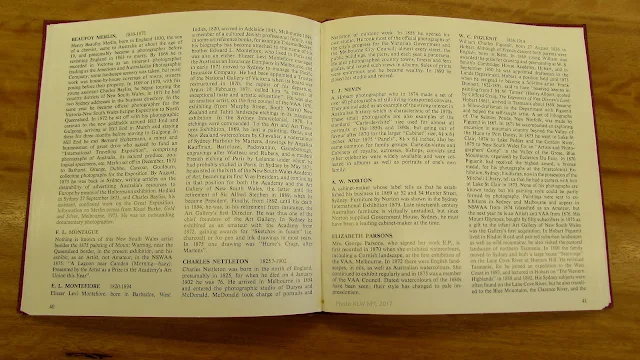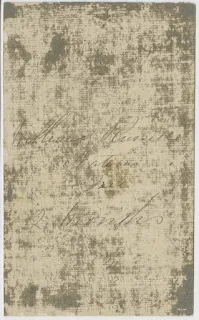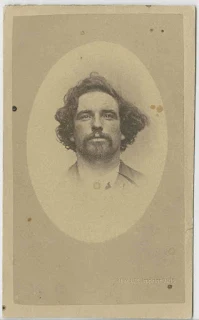WHO ARE YOU Exhibition NGV & NPG 2022
Wesley ENOCH contributor of cdv by T. NEVIN


Photographic works extant in public collections taken by Thomas J. Nevin (1842-1923) in Tasmania during the 1860s and 1870s are regularly displayed at exhibitions held by Australian national galleries and museums. In many cases, a publication in book form accompanies the exhibition. For example, for their 2015 exhibition of The Photograph and Australia, the Art Gallery of New South Wales, Sydney chose a stereograph taken by Thomas J. of Nevin of his studio in Elizabeth St. Hobart ca. 1868, one of at least a hundred rare stereographs and portraits by Nevin housed at the Tasmanian Museum and Art Gallery, Hobart.

Stereograph by Thomas J Nevin bottom of page 270
Catalogue for the exhibition The Photograph and Australia, Judith Annear (ed)
Art Gallery of NSW, 21 March - 8 June 2015.
Photo copyright © KLW NFC 2015 ARR

The accompanying publication to the exhibition, The Photograph and Australia, listed the stereograph on page 296 with these details:
Thomas J Nevin
Elizabeth St 1860s
stereograph
7.3 x 7 cm (each)
8.5 x 17.4 cm (card)
Tasmanian Museum and Art Gallery, Hobart
Q1994.56.12
"Who Are You" 2022
This year's exhibition titled WHO ARE YOU includes a hand-tinted carte-de-visite of a woman yet to be identified, taken by Hobart professional photographer Thomas J. Nevin in the 1860s. The exhibition of 230 works - 79 from the National Portrait Gallery in Canberra, and 160 from the National Gallery of Victoria, Melbourne - represent photography, painting, sculpture, works on papers and video.
The curatorial rationale of the exhibition:
WHO ARE YOU: Australian Portraiture is the first exhibition to comprehensively bring together the rich portrait holdings of both the National Gallery of Victoria, Melbourne, and the National Portrait Gallery, Canberra. Revealing the artistic synergies and contrasts between the two institutions’ collections, this co-curated exhibition considers portraiture in Australia across time and media....
WHO ARE YOU: Australian Portraiture questions what constitutes a portrait - historically, today and into the future. The connection between the artist, sitter, and viewer is considered throughout the exhibition, creating opportunities for new perspectives to emerge from this relationship. The curators have organised the works into five key themes, each one occupying a separate area of the exhibition space.
Person and Place examines the connection between identity and the land on which we live.
Meet the Artists celebrates self-portraits and portraits that artists have made of fellow artists.
Intimacy and Alienation reflects on love, family, friendship, isolation, mourning and nudity.
Inner Worlds considers how identity can be perceived through psychology, imagination, surrealism and fetish.
Icons honours the sitter portrayed in each portrait, emphasising who is remembered and who has been forgotten.


Screenshots: Virtual Tour of Who Are You: Australian Portraiture
https://www.ngv.vic.gov.au/virtual-tours/who-are-you/
National Gallery of Victoria, Melbourne from 25 March 22 to 21 August 2022
National Portrait Gallery, Canberra from 1 October 2022 to 29 January 2023
Visit: https://www.ngv.vic.gov.au/exhibition/who-are-you/
The Book of the Exhibition
The exhibition is accompanied by a publication produced by the NGV and features written reflections by some of Australia’s foremost writers, thinkers, artists and poets. Each author was invited to choose an artwork in the exhibition that resonated with their lived experience. This publication centres portraiture within contemporary conversations around identity, belonging and representation in Australia.Source: NGV Fact Sheet 1: WHO ARE YOU

WHO ARE YOU
Edited by Sophie Gerhard, Joanna Gilmour, Penelope Grist, David Hurlston, Hannah Presley and Beckett Rozentals, with contributors
NGV | National Portrait Gallery | Thames & Hudson

Who Are You: Australian Portraiture,NGV 2022
Introduction, p. xiii
Tony Ellwood AM
Director, National Gallery of Victoria
Karen Quinlan AM
Director, National Portrait Gallery
EXTRACT, Introduction
... With works spanning disciplines and chronologies, WHO ARE YOU challenges conventional assumptions around portraiture. The project celebrates the art form, revealing themes of inner worlds, intimate selves, identity, isolation, politics, celebrity and the social sphere. WHO ARE YOU features more that 200 works by renowned Australian artists, including Patricia Piccinini, Anton Ahem, Nora Heysen, Howard Arkely, Vincent Namatijira and Tracey Moffatt, and sitters including Cate Blanchett, Helena Rubenstein, Eddie Mabo, and Marcia Langton....
Carte-de-visite by T. Nevin

Who Are You: Australian Portraiture, pps 164-165
A selection of photographs by contributor Wesley Enoch.
Caption:
(left to right) T. Nevin, Hobart No Title (woman wearing a bonnet with a pink bow), carte-de-visite 1865-67 National Gallery of Victoria, Melbourne
John Bishop-Osborne No title (Child standing on a chair and holding a whip), carte-de-visite 1879-83 National Gallery of Victoria, Melbourne
Burman & Co., Melbourne No title (Man) , carte-de-visite 1876-77 National Gallery of Victoria, Melbourne
James E. Bray Madame Sibly, Phrenologists and mesmerist ca. 1870 National Portrait Gallery, Canberra

Who Are You: Australian Portraiture p.270
T. Nevin, Hobart Australia 1865-67
No Title (woman wearing a bonnet with a pink bow), carte-de-visite (1865-67)
albumen silver photograph,
watercolour
9.5 x 5.8 cm (image and support)
National Gallery of Victoria, Melbourne
Presented through the NGV Foundation
by John McPhee, Member 2003
(2003.395)
Contributor Wesley Enoch

Who Are You: Australian Portraiture p.275
WESLEY ENOCH AM is a writer and director. He hails from Stradbroke Island (Minjerribah) and is a proud Quandamooka man. Enoch was artistic directror of Sydney Festival from 2017 to 2020, and was previously artistic director at IIbijerri Aborginal and Torres Strait Islander Theatre Cooperative and associate artistic director at Belvoir Street Theatre. He was creative consusltant, segment director and indigenous consultant for the 2018 Gold Coast Commonwealth Games. Enoch has written and directed numerous Indigenous theatre productions; his most recent is the Australian premiere of Appropriate by Branden Jacobs-Jenkins at the Sydney Theatre Company.

Who Are You: Australian Portraiture p.161
Contributor to the exhibition and publication, Wesley Enoch prefaced his choice of items from the NGV and NPG collections with this statement in which he raises the question significant to memorialising the deceased. The carte-de-visite by T. Nevin was one of a dozen included in his selection.
EXTRACT: Wesley Enoch's Preface, p. 161
Portrtaits are an act of love and care, of memory and storytelling, of finding a physical form to display the invisible and, most of all, a demonstration of belonging ...
... A long-ago tradition dictates that the death of a family member heralds the cessation of speaking their name and the burning or abandonment of their few treasured belongings. This tradition has slowly evolved into new cultural practices that respond to technological advances like photography (though we are slower to respond to video and social media - what do we do with Facebook pages of the deceased? The birthday reminders? Their online collection of pics, vids and comments?) ....
T. Nevin's cdv of Woman with Pink Bow
Apposite, perhaps, that the question posed by the exhibition's title "Who Are You?" applies to this unidentified woman who wore a houndstooth check dress and floral bonnet with large ribbons when she was photographed in the Hobart studio of Thomas J. Nevin. The drape, table, chair, carpet and pose featured in this cdv are identical to the decor and pose in a cdv of a younger woman he photographed around the same time, held at the Tasmanian Museum and Art Gallery, Hobart. This item, however, unlike the cdv of the younger woman, was delicately hand-tinted. The original presenter of this cdv to the NGV in 2003, John McPhee, who curated the exhibition of Nevin's 1870s photographs of Tasmanian prisoners (mugshots of "convicts") at the Queen Victoria Museum and Art Gallery, Launceston in 1977, has dated this portrait to the mid 1860s.


National Gallery of Victoria Catalogue Notes
No title (woman wearing a bonnet with a pink bow), carte-de-visite
T. NEVIN, Hobart (1865-1867)
Medium albumen silver photograph, watercolour
Measurements 9.5 × 5.8 cm (image and support)
Place/s of Execution Hobart, Tasmania
Inscription printed in ink on support on reverse c. AD ALTIORA / CITY PHOTOGRAPHIC ESTABLISHMENT / T. NEVIN. / LATE / A. BOCK. / 140 ELIZABETH ST / HOBART TOWN. / Further copies / can be obtained at / any time.
Accession Number 2003.395
Department Australian Photography Credit Line National Gallery of Victoria, Melbourne
Presented through the NGV Foundation by John McPhee, Member, 2003
RELATED POSTS main weblog
- Woman with pink ribbons by Thomas Nevin 1870s
- Nevin's photographs at the Art Gallery NSW exhibition 2015
- Sideshow Alley: Thomas Nevin at the NPG exhibition 2015
- Convict photographs by T. J. Nevin at the Art Gallery NSW Centenary Exhibition 1976
- Lost and found: one day in 1866 and the scientific racism which followed
- Thomas Nevin's stereographs from the Pedder collection
- Exhibition 2019: T. J. NEVIN's mugshot of prisoner James BLANCHFIELD 1875
- Thomas Nevin's women clients and their dresses 1870s
- NLA's 'Intersections' with convict carte by Nevin





























